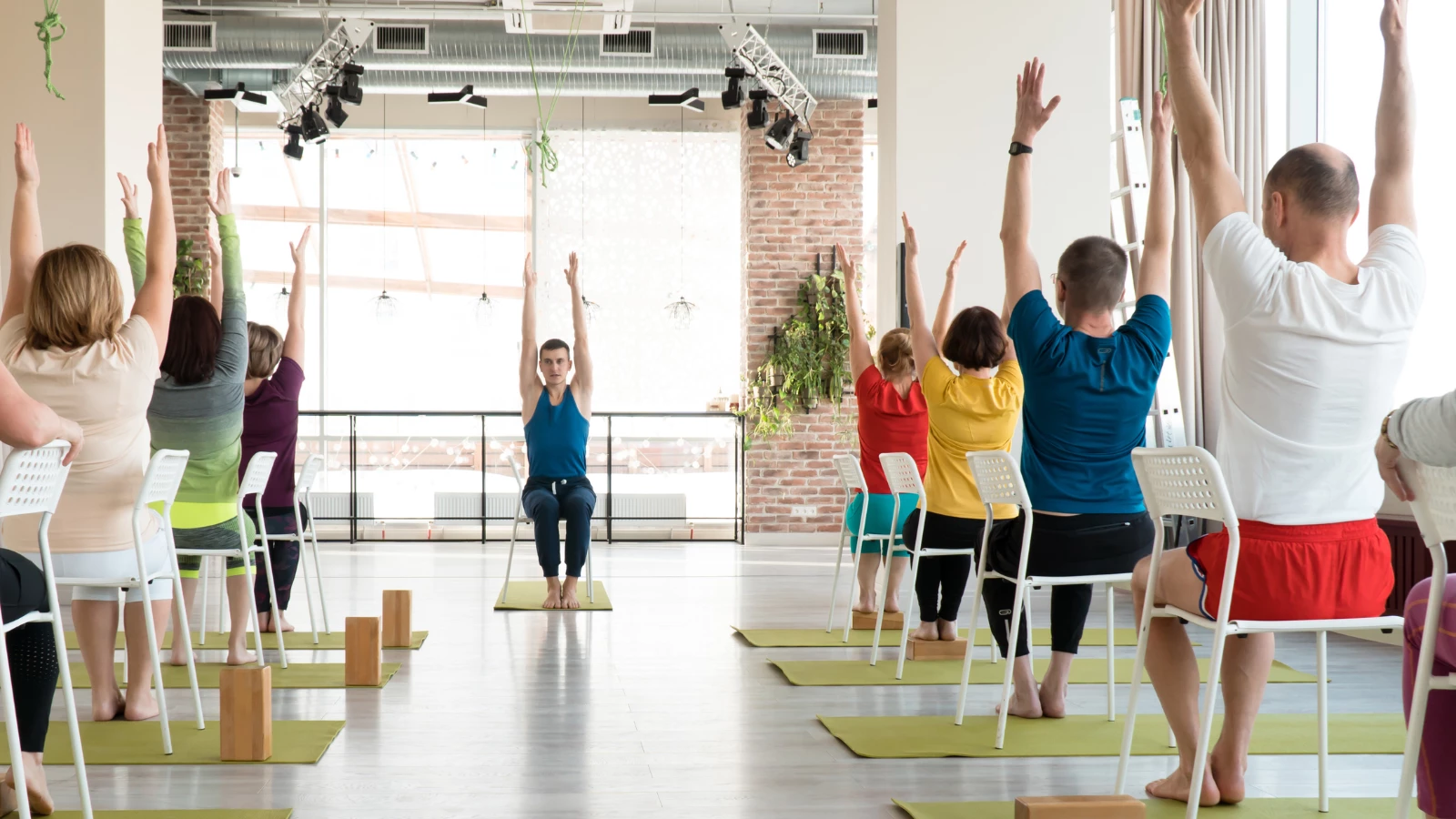What Are the Benefits of Chair Yoga?
5 Undeniable Reasons to Give It a Try

Article At A Glance
We all know the incredible benefits of movement and exercise. But unfortunately, high-impact running and lifting weights at the gym aren’t necessarily accessible to all. However, more often than not, there is a form of movement that is accessible to you. Yoga often comes to mind as an accessible practice, but there are quite a few movements and postures within a traditional yoga practice that don’t suit those with mobility issues well. But there is a yoga style that is highly accessible and can be practiced by anyone who can sit in a chair. Chair yoga is the perfect practice for those with movement challenges.
But chair yoga also can be challenging enough for those that don’t have movement restrictions. Just like all other yoga practices, it’s highly adaptable and can be modified to suit the practitioner. This is just the first of many benefits of chair yoga.
What Is Chair Yoga?
When most people first think of yoga, they imagine a practitioner in a pretzel-like, contorted shape, perhaps balancing on their arms with their feet behind their head. Most of us don’t consider sitting in a chair to count as yoga practice.
But yoga in a chair changes this perspective. Yoga can be practiced fully without ever leaving your seat, which can be especially useful for practitioners struggling with balance issues, mobility issues, and/or stiffness and pain.
Although it can be frustrating when age, illness, or injury restricts your movements or ability to exercise as you used to, chair yoga can be a beautiful practice to fill the gap so that you’re still able to benefit from exercise in a more gentle, supported, and controlled way.
Chair yoga is simply yoga practiced with the support of a chair. Most (if not all) traditional yoga postures can be practiced seated, using the assistance of a chair to support some or all of your body weight to lessen the load on your joints and muscles and limit the range of motion necessary to practice certain asanas.
It’s a wonderfully supportive practice that can accommodate all body types, ability levels, injuries, conditions, ages, and more. And while you might assume that chair yoga is an “easy” practice or not a “real” exercise, you may be pleasantly surprised by the long list of amazing benefits of chair yoga.
What Are the Benefits of Chair Yoga? Here Are 5 of the Most Important
These are just a few of the many amazing benefits of chair yoga.
1. Yoga in a Chair Improves Flexibility and Strength
It’s considered to be common knowledge that yoga improves flexibility, and chair yoga is no exception. Not only does chair yoga help improve range of motion through its movement of joints and gentle tugs on fascial and muscular lines, but a study found chair yoga may be beneficial in improving mobility and reducing fear of falling.
Yoga, including chair yoga, also helps to improve strength. Even though you are seated throughout a chair yoga practice (or at least using the support of a chair), you still create plenty of muscular activation to build strength and endurance, which can be especially helpful for those with injury or degeneration.
A study examining the effects of chair yoga on older adults with moderate to severe Alzheimer’s disease found positive changes across all measurements of physical fitness in participants, including the Six-Minute Walk Test, the Gait Speed Test, and the Berg Balance Scale. This seems to indicate that chair yoga helps to improve overall physical fitness levels through improvements in flexibility and strength.
2. Increases Interoceptive and Proprioceptive Awareness
Interoception is a lesser-known sense of the internal state of the body. Proprioception is the sense of movement, body position, and location.
When compared to a control group, a study found chair yoga to produce statistically significant improvements in body awareness for adults with neurodisability.
Through intentional, mindful, controlled, and safely supported movement, chair yoga can help to draw greater awareness within. This can be especially helpful for those with mobility or balance issues. This can translate beyond the yoga “class” into functional use in everyday life, which is one of the most enormously helpful benefits of chair yoga.
3. Reduces Pain
Yoga is known for its mindfulness elements, and this mindful awareness is important in pain tolerance. Pain science knows the importance of movement and awareness to improve the brain’s perception of pain, so it makes sense that chair yoga could help to improve pain sensation.
A pilot randomized controlled trial found that chair yoga was associated with reducing pain, pain interference, and fatigue in older adults with lower extremity osteoarthritis. Another study looking at the management of osteoarthritis showed significant relationships between physical function and chair yoga, and participants expressed feelings of improved health and well-being after the chair yoga intervention.
This likely comes as no great surprise to anyone who has tried and tested the benefits of chair yoga. Through mindful awareness and gentle movements, chair yoga has the potential to reduce pain in those who practice regularly.
4. Elicits the Relaxation Response
The relaxation response is essentially the counterpart to the body’s stress response. It helps to shift the body from the fight-or-flight side of the nervous system (the sympathetic branch) to the rest-and-digest side of the nervous system (the parasympathetic branch).
A study examining the effectiveness of 15 minutes of chair-based yoga postures and guided meditation performed in an office found that all it took was this simple practice to elicit a relaxation response.
This massive benefit of yoga in a chair blended with meditation can help to shift the nervous system into a parasympathetic-dominant state. Along with this comes many health and wellness benefits, including reduced heart rate, reduced respiration rate, and so much more.
5. Reduces Stress and Anxiety
Of course, less pain leads to less stress and anxiety. And a parasympathetic-dominant autonomic nervous system also physiologically reduces stress and anxiety significantly.
The same study found that “yoga postures or meditation performed in the office can acutely improve several physiological and psychological stress markers.” They also found that “yoga and meditation significantly reduced perceived stress versus control, and this effect was maintained post-intervention.”
The Benefits Are Plentiful
Yoga in a chair offers a plethora of benefits that are not small or trivial. This is only a handful of the many benefits of chair yoga, but hopefully, they’re all important enough to inspire you to begin a chair yoga practice.
Whether you struggle to get up and down from the floor or have injuries or conditions that prevent you from practicing traditional yoga with ease, or you’re simply looking for a way to spice up your usual yoga practice, then give chair yoga a try. You just might be surprised by the many benefits it has to offer.
Also, read...
Do Yoga and Meditation Reduce Health-Care Utilization? What Studies Say
Age-Related Posture Slump? Yoga Can Help Alleviate Hyperkyphosis, Study Suggests
How Exercise Might Help Brain and Nervous System Health
Related courses
Breath as Medicine: Yogic Breathing for Vital Aging
Yoga and Myofascial Release: Releasing Chronic Tension with the Bodymind Ballwork Method
Yoga and Detoxification: Tips for Stimulating Lymphatic Health

Leah Sugerman is a yoga teacher, writer, and passionate world traveler. An eternally grateful student, she has trained in countless schools and traditions of the practice. She teaches a fusion of the styles she has studied with a strong emphasis on breath, alignment, and anatomical integrity. Leah teaches workshops, retreats, and trainings, both internationally and online. For more information, visit www.leahsugerman.com.







